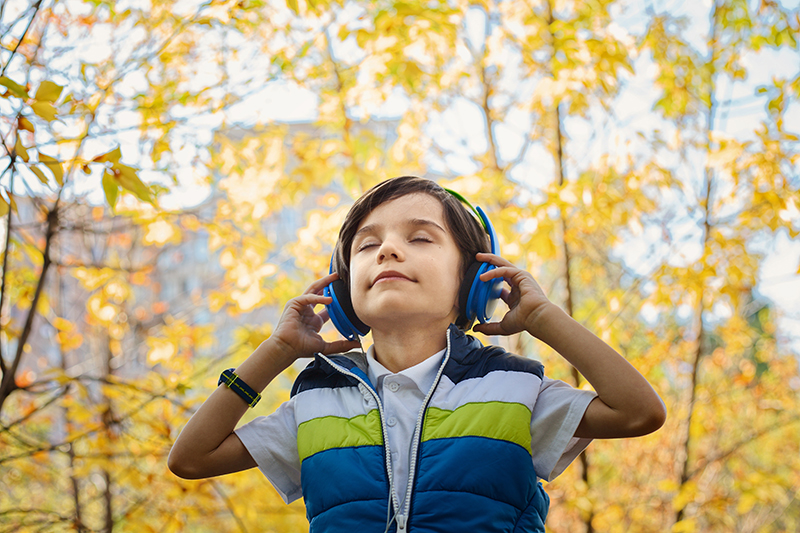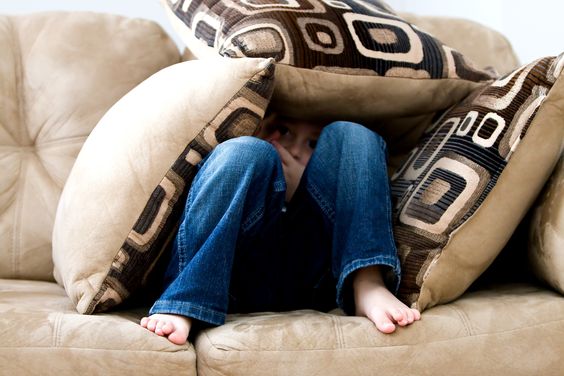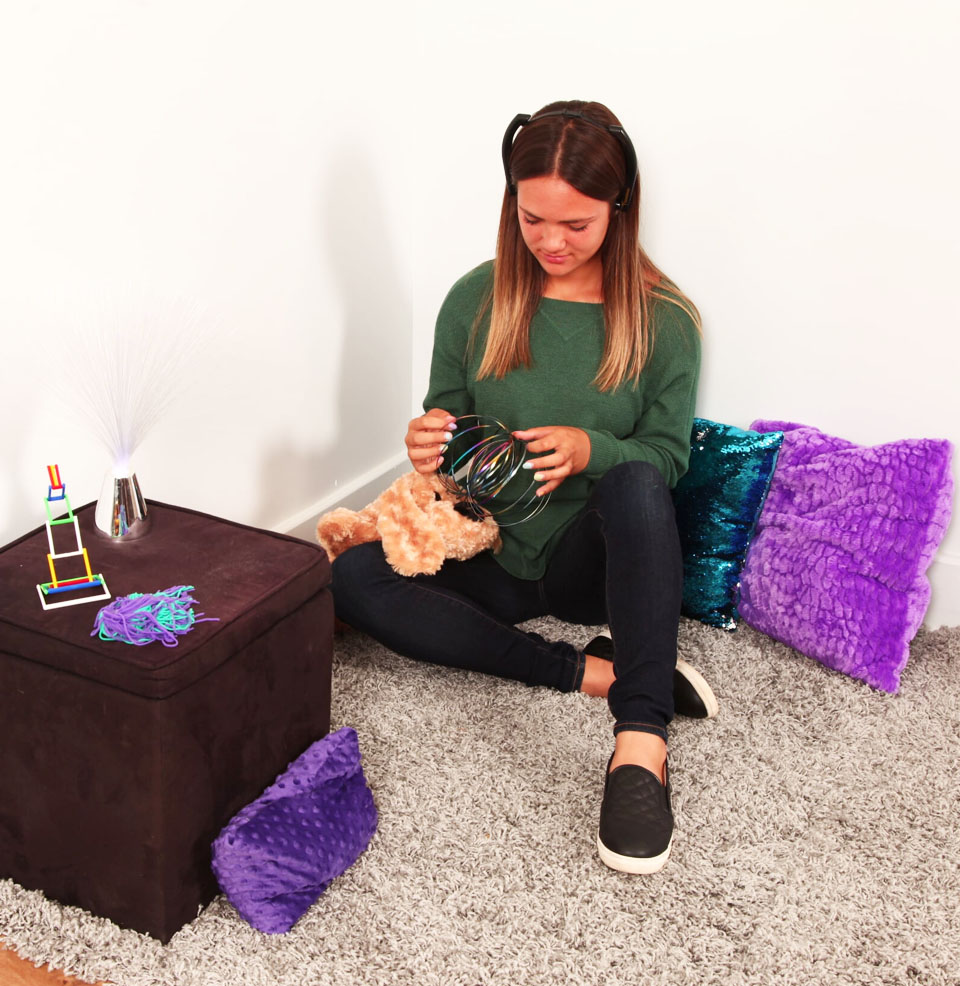 2. Do deep breathing exercises together to help slow your heart rate and relax muscles. Ask your child to "breathe in" the rainbow and with each color, to think of favorite things that match that color. An adult may need to verbalize the steps while children close their eyes and follow along. Or consider having the child draw a picture of a rainbow to look at (to help visualize the rainbow breathing exercise).
2. Do deep breathing exercises together to help slow your heart rate and relax muscles. Ask your child to "breathe in" the rainbow and with each color, to think of favorite things that match that color. An adult may need to verbalize the steps while children close their eyes and follow along. Or consider having the child draw a picture of a rainbow to look at (to help visualize the rainbow breathing exercise).
3. Practice yoga. Have daily yoga sessions at home using kid-friendly resources like Yoga Pretzel Activity Cards, Yoga Dice, or a Yoga Games like Yoga Spinner – that feature yoga activities appropriate for the whole family. Many yoga websites are temporarily offering reduced prices and/or free yoga activities/classes for families right now!
4. Use deep pressure input and "heavy work" tasks to help stabilize your child's sensory system. Make a sandwich with the child in between two sofa pillows--or roll a child in a blanket with their head and feet sticking out of each end to make a giant hotdog and add condiments using deep pressure to "spread" the mustard or to "dab" the pickles on. Cuddle under a weighted blanket. Have your  child lie down and use a regular wooden or a sensory rolling pin on their back to "roll out the worries." Lift or push full laundry baskets of clothing.Fill large watering cans to water outdoor shrubs/flowers. Give and get lots of bear hugs. Do animal walks. Jump rope. Make indoor obstacle courses. Play Tug of War. Throw bean bags at a target. Have stress balls, fidgets, and putty available for busy fingers. Use a large ball for a ball chair. Do yoga (see #3 above) and exercises like jumping jacks, wall or chair push-ups that can all be great sources of calming deep pressure input. Play hopscotch or "go bowling" using weighted balls and activity cones. Have your child push themself on a scooter board. Provide drawings of heavy work options that are available so a child can pick, or put them in a bag for a child to pull out an activity as needed.
child lie down and use a regular wooden or a sensory rolling pin on their back to "roll out the worries." Lift or push full laundry baskets of clothing.Fill large watering cans to water outdoor shrubs/flowers. Give and get lots of bear hugs. Do animal walks. Jump rope. Make indoor obstacle courses. Play Tug of War. Throw bean bags at a target. Have stress balls, fidgets, and putty available for busy fingers. Use a large ball for a ball chair. Do yoga (see #3 above) and exercises like jumping jacks, wall or chair push-ups that can all be great sources of calming deep pressure input. Play hopscotch or "go bowling" using weighted balls and activity cones. Have your child push themself on a scooter board. Provide drawings of heavy work options that are available so a child can pick, or put them in a bag for a child to pull out an activity as needed.
5. Use Visualization Exercises. Have the child close his/her eyes and imagine walking along a warm beach, listening to the sounds of the waves, and as they walk along, have the sand gradually change colors to match the rainbow… red then green, etc. The adult may need to verbalize the steps while children close their eyes and follow along.
 6. Create a Calming Corner in your home and/or make a custom Relaxation Kit. Have your kids think of things that provide comfort and/or distractions to have available: beanbag chair, stress balls, stuffed animals, relaxing music, coloring books and crayons, drawing materials, fidgets, books to read, tracing cards, calming scented tools, etc.
6. Create a Calming Corner in your home and/or make a custom Relaxation Kit. Have your kids think of things that provide comfort and/or distractions to have available: beanbag chair, stress balls, stuffed animals, relaxing music, coloring books and crayons, drawing materials, fidgets, books to read, tracing cards, calming scented tools, etc.
7. Do progressive Muscle Relaxation Exercises. Tense a muscle group (i.e., your face muscles, or a leg) for 5 seconds, then release and pay attention to how it feels when relaxed. Proceed from head to foot. The adult may need to verbalize the steps while children follow along.
8. Indulge in Distractions. Watch movies, do puzzles, play board games, make crafts, read a book, take a bubble bath, give back rubs, pet the dog or cat, bake a favorite recipe, look at family photo albums, learn some new magic or card tricks, and do other fun things to keep minds off stressful things.
9. Remember that children also learn and process information the best through playing. Encourage and let them PLAY, PLAY, PLAY!
10. Create Social Stories for your child. In a nutshell, Social Stories are short personalized stories (often paired with images), that provide a description of a situation, activity, or event and include information/answers about the who, what, when, where, and why's of a situation. Originally created for children on the autism spectrum, Social Stories can be an effective tool for preventing and/or addressing anxiety with any child. Think of them as a "game plan" to help kids mentally plan and prepare for daily events. Most Social Stories are typically written from a child's perspective using reassuring, positive language with descriptive, affirming, directive sentences.
____________________
Read other articles in this series: How to Help Children Express Their Worries and Fears
©2020 Therapy Shoppe® Incorporated. All rights reserved.
